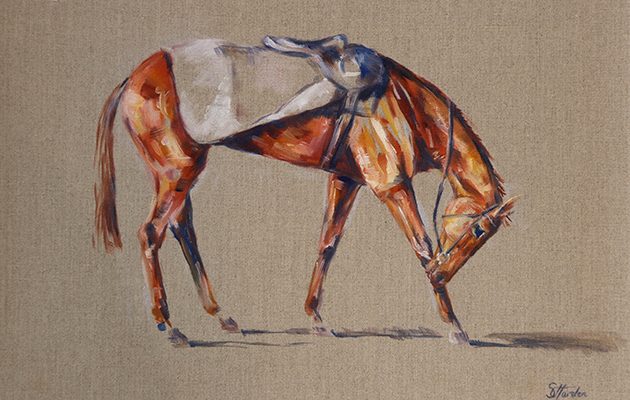Days out with the Pytchley inform much of Sophie Harden’s work, though a trip to Africa has provided fresh challenges, she tells Janet Menzies
The great hunting painters of the past would approve of Sophie Harden – her work is informed by her days out with the Pytchley. But it was a trip to Africa that presented a fresh challenge, as she tells Janet Menzies.
For more sporting artists, the sculptures by Tom Hill are made by sport, for sport. And Geoffrey Sparrow offers hunting and country scenes from an insider’s perspective.
SOPHIE HARDEN
It is actually a legal requirement that a hunting artist must hunt regularly. No, really, Raoul Millais got it accepted as a tax deductible expense while Dr Geoffrey Sparrow used his hunters to go to work as a country doctor. So it is wonderful that, despite her very contemporary approach to her subject, Sophie Harden is fulfilling her obligations as a sporting artist by getting out with the Pytchley as often as possible.
Meanwhile, she has recently been on an artistic safari to Africa, which has filled her sketchbook and camera with unforgettable images to work on back home in her Northamptonshire studio. The trip was something Harden had been hoping to do for several years: “I had gone out to South Africa in my gap year and ended up spending six months there,” she remembers, “so when the opportunity came up to go out to Kenya, to the northern part of the Mara, I was thrilled. We were lucky to stay with friends who live and work in the area and they helped us to find the game. On the Mara River we saw hippo and crocodiles.”
Harden’s safari got even more exciting as she drove onto the Laikipia plateau to stay at Sosian camp: “The previous year there had been a lot of tension with nomadic herdsmen but things had relaxed, so I was able to go out on horse safari in this very wild area. At one moment there were antelope and zebra running alongside us, disturbed by two lionesses.”

Kiboko in Water.
Even more exciting was sharing a morning drink with an enormous herd of elephants at the Mugie camp: “We were out early in the morning and the elephants came to the lake and drank – a herd of about 50 – babies, mothers, big bulls. We just sat there and couldn’t take our eyes off them.” But one of the young adult males took exception to being stared at: “He did a false charge at us. He was just flexing his muscles, and I got a brilliant shot of him turning side on.”
CAPTURING A MOMENT
Back in the studio, capturing this moment was one of Harden’s first challenges. “I have done a big charcoal study of him – it has turned out to be a metre and a half across. Now I have to work on translating that into the oil-painting version. I have just completed a huge rhino, which I saw where they are doing a big anti-poaching project. I took a lot of photos and did a lot of sketches and I’m still going through all the material now. One of the things that helped a lot was just hiring a car and getting advice from local guides and going it alone – it meant I wasn’t under the same pressure to keep moving on so I could really observe the animals. My style of just using white for these African pictures is working really well because of the early morning and late evening light, which has a monochrome feel to it.”
Harden’s style is indeed distinctive. Racehorses gallop across a single colour ground, their movement highlighted in just a few white brushstrokes. She explains: “About a year or so ago I was just fiddling around in my studio and I started doing an oil ground, thinning it down with turps as a wash and leaving that to dry and then going on with just one colour. I found you could change the perspective. I think of the background as the darker colour and then building up the white brush strokes on top to show the light. The light alone builds up the rest of the image in the viewer’s mind, even though it may be only suggested. I’m pleased that it gives a lot of movement. Now I am experimenting with other colours, like orange and pink. I’m not sure these have enough depth, but for the African work they seem to capture that red of the soil there. I am also experimenting with two colours in the wash, but I must be careful not to over-complicate the colours.”
The technique works especially well with Harden’s racehorse paintings, which reflect her long experience of riding thoroughbreds most days. “I used to ride out for a point-to-point yard and ended up doing a charity race at Ascot, which was amazing. So point-to-pointing is on my bucket list. But for now I am just sticking with my hunting. You meet so many great people out hunting. I’m often chatting to people and networking.”
Those hunting painters of the past, Lionel Edwards and Alfred Munnings, would certainly approve of this new generation of sporting artist.
Sophie Harden is planning several exhibitions in 2019. For the latest news, call her on 07740 777488, check out her website at www.sophieharden.co.uk or visit The Mall Galleries at www.mallgalleries.org.uk





